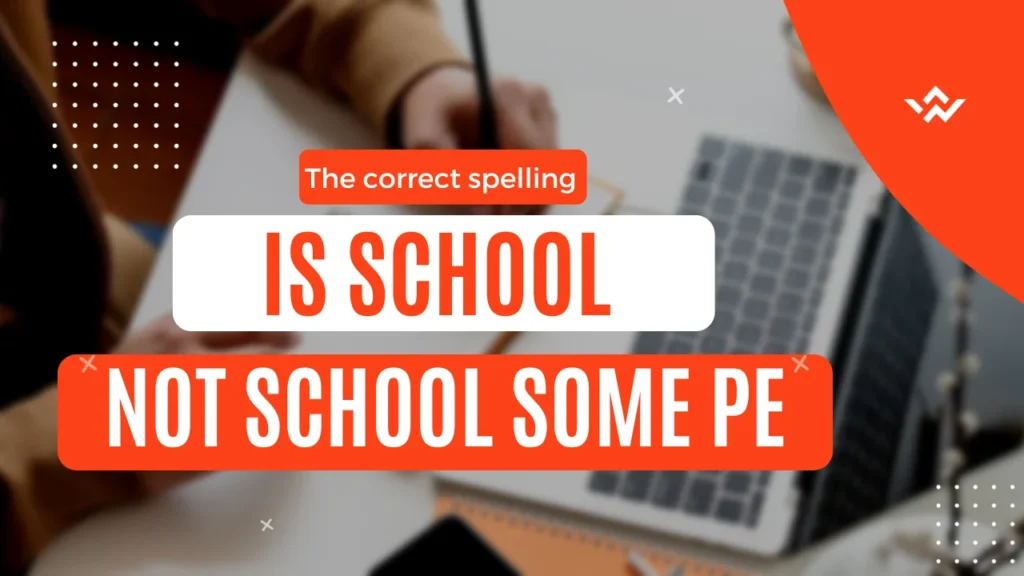
In the digital age, where communication occurs primarily through written text, the importance of spelling accuracy cannot be overstated. However, despite the prevalence of spell-checking tools and autocorrect features, typographical errors remain a common occurrence. One such example is the confusion between “school” and “school.” In this article, we delve into the nuances of this typographical error, explore its origins, and offer strategies for avoiding such mistakes in written communication.
Defining the Typographical Error:
The correct spelling is school not school. Some people may inadvertently type “school” instead of “school” due to the proximity of the keys “c” and “l” on a standard keyboard. This typographical error often goes unnoticed, especially in informal communication channels such as emails, text messages, and social media posts. However, it can lead to confusion and misinterpretation, particularly in professional or academic contexts where accuracy and precision are paramount.
Origins of the Typographical Error:
The origins of the typographical error “school” instead of “school” can be traced back to the QWERTY keyboard layout, which was designed in the 19th century for mechanical typewriters. The layout was optimized to prevent jamming by placing commonly used letters apart from each other. However, this layout also led to the proximity of certain letters, such as “c” and “l,” which are adjacent on the keyboard. As a result, typists may inadvertently strike the wrong key, leading to typographical errors like “school” instead of “school.”
Common Instances of the Typographical Error:
The typographical error “school” instead of “school” is prevalent in various forms of written communication, including emails, text messages, social media posts, and even printed materials. It often occurs when individuals type quickly or fail to proofread their writing thoroughly. In academic papers, business documents, and official correspondence, such errors can undermine the credibility and professionalism of the writer, highlighting the importance of vigilance and attention to detail in written communication.
Impacts of the Typographical Error:
The typographical error “school” instead of “school” can have several consequences, ranging from minor misunderstandings to significant communication breakdowns. In informal contexts, such as casual conversations or personal emails, the error may go unnoticed or be easily corrected by the reader. However, in professional or academic settings, where precision and accuracy are paramount, the error can detract from the credibility and effectiveness of the message. It may lead to confusion, misinterpretation, and even embarrassment for the writer.

Strategies for Avoiding Typographical Errors:
To prevent typographical errors like “school” instead of “school,” individuals can adopt several strategies to improve their writing accuracy and precision. These include:
- Utilize Spell-Checking Tools: Take advantage of spell-checking features available in word processing software, email clients, and web browsers. These tools can help identify and correct typographical errors before finalizing written documents.
- Proofread Thoroughly: Always proofread written communication carefully before sending or publishing it. Take the time to review the text for spelling errors, grammatical mistakes, and typos. Reading the text aloud or asking a colleague to review it can help catch errors that may have been overlooked.
- Practice Typing Skills: Improve typing accuracy by practicing touch typing techniques and familiarizing yourself with the keyboard layout. This can help reduce the likelihood of striking the wrong keys inadvertently, especially when typing quickly.
- Be Mindful of Common Errors: Pay attention to common typographical errors, such as “school” instead of “school,” and make a conscious effort to avoid them in your writing. Awareness of these errors can help prevent them from occurring and improve overall writing quality.
Conclusion:
The correct spelling is school not school. Some pe – tymoff The typographical error “school” instead of “school” may seem minor, but it can have significant implications for written communication. By understanding the origins of the error, recognizing common instances, and implementing strategies for prevention, individuals can enhance their writing accuracy and professionalism. Whether in academic, professional, or personal contexts, attention to detail and vigilance in proofreading are essential for effective communication and avoiding misunderstandings.
(FAQs)
- What is a typographical error?
- A typographical error, often referred to as a typo, is a mistake made during the typing or printing process that results in the incorrect spelling, punctuation, or formatting of a word or phrase.
- What is the difference between “school” and “school”?
- The correct spelling is “school,” which refers to an educational institution. The incorrect spelling “school” is a typographical error that occurs when the letters “c” and “l” are inadvertently typed in the wrong order.
- Why do typographical errors occur?
- Typographical errors can occur for various reasons, including typing quickly, failing to proofread carefully, and the proximity of keys on a keyboard. In the case of “school” instead of “school,” the error often arises due to the adjacent placement of the letters “c” and “l” on a standard keyboard.
- How can typographical errors impact written communication?
- Typographical errors can impact written communication by leading to confusion, misinterpretation, and a loss of credibility. In professional or academic settings, such errors may undermine the effectiveness of the message and detract from the writer’s professionalism.
- What are some common instances of typographical errors?
- Common instances of typographical errors include misspelled words, incorrect punctuation, and formatting mistakes. Examples of typographical errors similar to “school” instead of “school” include “form” instead of “from” and “hte” instead of “the.”